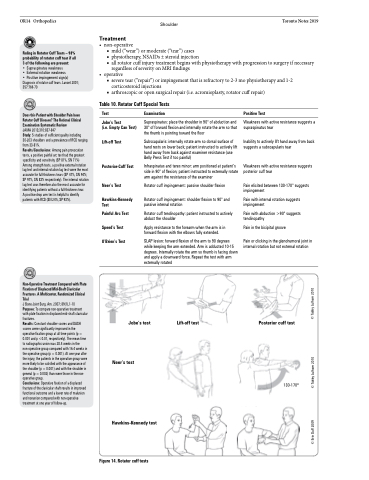Page 948 - TNFlipTest
P. 948
OR14 Orthopedics
Shoulder
Toronto Notes 2019
Ruling in Rotator Cuff Tears – 98% probability of rotator cuff tear if all 3 of the following are present:
• Supraspinatus weakness
• External rotation weakness
• Positive impingement sign(s) Diagnosis of rotator cuff tears. Lancet 2001; 357:769-70
Does this Patient with Shoulder Pain have Rotator Cuff Disease? The Rational Clinical Examination Systematic Review
JAMA 2013;310:837-847
Study: 5 studies of sufficient quality including 30-203 shoulders and a prevalence of RCD ranging from 33-81%.
Results/Conclusions: Among pain provocation tests, a positive painful arc test had the greatest specificity and sensitivity (SP 81%, SN 71%) Among strength tests, a positive external rotation lag test and internal rotation lag test were the most accurate for full-thickness tears (SP 47%, SN 94%; SP 97%, SN 83% respectively). The internal rotation lag test was therefore also the most accurate for identifying patients without a full-thickness tear.
A positive drop arm test is helpful to identify patients with RCD (SN 24%, SP 93%).
Treatment
• non-operative
■ mild (“wear”) or moderate (“tear”) cases
■ physiotherapy, NSAIDs ± steroid injection
■ all rotator cuff injury treatment begins with physiotherapy with progression to surgery if necessary
regardless of severity on MRI findings • operative
■ severe tear (“repair”) or impingement that is refractory to 2-3 mo physiotherapy and 1-2 corticosteroid injections
■ arthroscopic or open surgical repair (i.e. acromioplasty, rotator cuff repair)
Table 10. Rotator Cuff Special Tests
Test
Jobe’s Test
(i.e. Empty Can Test)
Lift-off Test
Posterior-Cuff Test
Neer’s Test
Hawkins-Kennedy Test
Painful Arc Test Speed’s Test O’Brien’s Test
Examination
Supraspinatus: place the shoulder in 90° of abduction and 30° of forward flexion and internally rotate the arm so that the thumb is pointing toward the floor
Subscapularis: internally rotate arm so dorsal surface of hand rests on lower back; patient instructed to actively lift hand away from back against examiner resistance (use Belly Press Test if too painful)
Infraspinatus and teres minor: arm positioned at patient’s side in 90° of flexion; patient instructed to externally rotate arm against the resistance of the examiner
Rotator cuff impingement: passive shoulder flexion
Rotator cuff impingement: shoulder flexion to 90° and passive internal rotation
Rotator cuff tendinopathy: patient instructed to actively abduct the shoulder
Apply resistance to the forearm when the arm is in forward flexion with the elbows fully extended.
SLAP lesion: forward flexion of the arm to 90 degrees while keeping the arm extended. Arm is adducted 10-15 degrees. Internally rotate the arm so thumb is facing down and apply a downward force. Repeat the test with arm externally rotated
Positive Test
Weakness with active resistance suggests a supraspinatus tear
Inability to actively lift hand away from back suggests a subscapularis tear
Weakness with active resistance suggests posterior cuff tear
Pain elicited between 130-170° suggests impingement
Pain with internal rotation suggests impingement
Pain with abduction >90° suggests tendinopathy
Pain in the bicipital groove
Pain or clicking in the glenohumoral joint in internal rotation but not external rotation
Posterior cuff test
130-170o
Non-Operative Treatment Compared with Plate Fixation of Displaced Mid-Shaft Clavicular Fractures. A Multicenter, Randomized Clinical Trial
J Bone Joint Surg. Am. 2007; 89(1),1-10 Purpose: To compare non-operative treatment with plate fixation in displaced mid-shaft clavicular fractures.
Results: Constant shoulder scores and DASH scores were significantly improved in the operative fixation group at all time-points (p = 0.001 and p <0.01, respectively). The mean time to radiographic union was 28.4 weeks in the non-operative group compared with 16.4 weeks in the operative group (p = 0.001). At one year after the injury, the patients in the operative group were more likely to be satisfied with the appearance of the shoulder (p = 0.001) and with the shoulder in general (p = 0.002) than were those in the non- operative group.
Conclusions: Operative fixation of a displaced fracture of the clavicular shaft results in improved functional outcome and a lower rate of malunion and nonunion compared with non-operative treatment at one year of follow-up.
Jobe’s test
Neer’s test
Hawkins-Kennedy test
Lift-off test
Figure 14. Rotator cuff tests
© Erin Duff 2009 © Tabby Lulham 2010 © Tabby Lulham 2010


